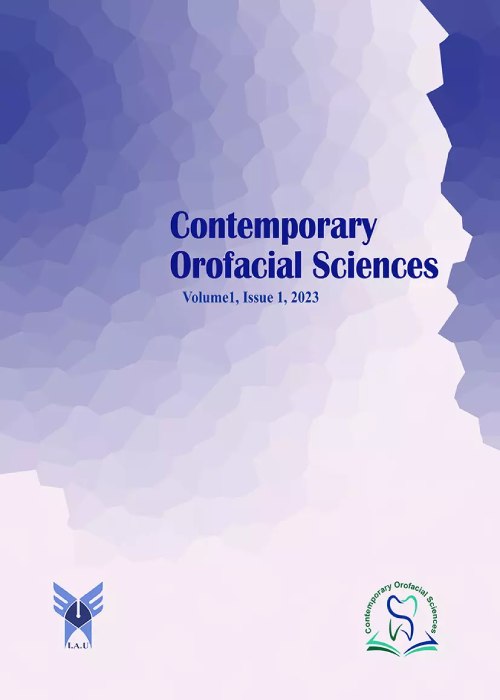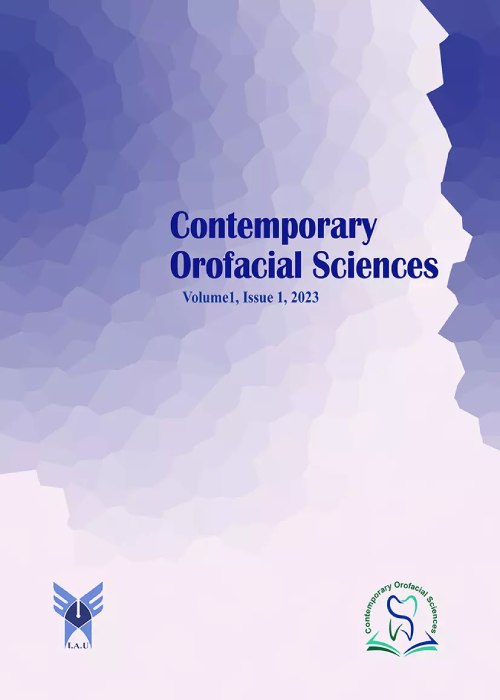فهرست مطالب

Contemporary Orofacial Sciences
Volume:1 Issue: 2, Summer 2023
- تاریخ انتشار: 1402/07/09
- تعداد عناوین: 7
-
Pages 1-5Background
The present study aimed to use a DIAGNOdetnt unit to compare the effects of casein phosphopeptideamorphous calcium phosphate fluoride (CPP-ACPF), 0.05% sodium fluoride (NaF) mouth rinse, and glass ionomer (GI) on enamel remineralization.
Materials and MethodsThis in vitro study was performed on 50 intact human premolars in five groups: A (artificial saliva), B (CPP-ACPF), C (NAF), D (GI), and E(GI+NAF). All samples were assessed using a DIGNOdetnt unit before and after demineralization. The teeth in each group were treated (except for the control group) then pH cycled repeatedly for 30 days. After this, the remineralization evaluation was evaluated. Data gathered by DIAGNOdetnt were analyzed by One way analysis of variance. The least significant difference (LSD) test was used for multiple comparisons (α=0.05).
ResultsAfter the treatment, the mean DIAGNOdetnt values in groups B(3.6), C(4.7), D (5.1), and E(3.5) were significantly lower than that in group A(P<0.0001). LSD test showed that the mean DIAGNOdetnt value in groups B and E was lower than for groups C and D(P<0.001).
ConclusionAlthough the repeated application of all the experimental materials was efficient, CPP-ACPF and GI+NAF had more prominent remineralization potential in comparison to NAF and GI alone.
Keywords: CPP-ACPF, DIAGNOdetnt, Glass ionomer, NAF rinse, Remineralization -
Pages 6-12Background
Besides standard periodontal procedures, additional approaches, including medication, laser therapy, and photodynamic therapy are employed to manage excessive inflammation and pathological reactions. The present study aimed to evaluate laser and photodynamic therapy (PDT) as complementary treatments for periodontitis.
Materials and MethodsThis clinical trial enrolled 12 patients (30-60 yrs.)With periodontitis stages I and II. Following initial treatment, one quadrant served as the control, one treated with a diode laser, and the other one with Photosan wavelength power with methylene blue dilution. Clinical variables including bleeding on probing (BOP), pocket depth (PD), and clinical attachment level (CAL) were measured and surveyed. Also, samples from gingival crevicular fluid were taken at 2 and 6 weeks for evaluation. The data collected were analyzed using the Friedman test, ANOVA, Kruskal-Wallis, and LSD post-test.
ResultsThe mean bacteria levels in all three treatment groups were significantly reduced (P < 0.001). There were no significant differences in P.g and P.i bacteria (P > 0.05) in all three treatment methods. A.as was notably reduced at 6 weeks (P = 0.037). CAL and PD significantly decreased in all three treatment groups (P < 0.001), with no statistically significant difference between the treatment methods (P > 0.05). The mean BOP significantly decreased in the laser therapy (P < 0.001) and PDT groups (P < 0.002).
ConclusionThis study found that diode laser therapy and PDT can effectively reduce periopathogens, particularly A.a, and improve clinical signs in patients with periodontitis stages I and II.
Keywords: Chronic periodontitis, Laser therapy, Photodynamic therapy -
Pages 13-19Background
The most important change in the mechanical properties of endodontically-treated teeth is the reduction of fracture strength. The aim of the present study was to compare the fracture strength of teeth restored with bulk-fill composite, flowable bulk-fill composite and conventional composite resin in the presence or absence of fiber.
Materials and MethodsIn this laboratory study, 120 intact maxillary first premolar teeth were selected and placed in eight groups. The groups were designed with three types of composites (conventional, bulk-fill, flowable bulk-fill) with and without fiber and two negative control groups and positive, Mesio-occlusal-distal (MOD) cavity was prepared in all groups. After the endodontics, the composite of the same group was used in each group to restore the teeth by incremental method. All restorations were polished, mounted and tested by Universal testing machine.
ResultsThe fracture strength in the fiber-reinforced bulk-fill composite group was significantly higher than the fiber-free group. The teeth restored with fiber-free composites had lower fracture strength. The fracture strength was the same in the samples treated with conventional and bulk-fill composite resins, and it was significantly lower in the samples treated with flowable bulk-fill composite than those treated with conventional and bulk-fill composites. There was a significant difference in fracture strength of fiber-reinforced composites.
ConclusionTooth restoration reduces fracture strength. Fiber addition has no significant effect on increasing the fracture strength of composites.
Keywords: Fracture strength, Bulk fil composite, flowable bulk fill composite, Ribbon fibers -
Pages 20-24Background
With a proper understanding of smile esthetic indices and criteria, dentists can provide patients with the best diagnosis and treatment plan or refer them to relevant specialists. Thus, This study aimed to evaluate the knowledge of general dentists in Isfahan regarding smile aesthetic indices and criteria.
Materials and methodsIn this descriptive cross-sectional study a questionnaire was administered to 105 general dentists in Isfahan City, consisting of questions about demographics, awareness of smile aesthetics indicators, and the impact of training and occupational therapy on their knowledge. The questionnaire included 11 pictures of smiles, each with a single beauty indicator that varied from ideal, with options for desired indicators listed for each photo. The data was analyzed using T-tests and Mann-Whitney statistical tests (α=0.05).
ResultsThe results showed that the level of knowledge about smile esthetic indices among general dentists was varied. Among participants, 56.2% and 1.0% showed the highest and lowest level of knowledge, respectively. Age showed a reverse relation to knowledge (P=0.040, r= -0.201) even though no correlation between gender and beauty retraining courses to knowledge was found (p > 0.05).
ConclusionThe level of knowledge of dentists participating in the study of smile esthetic indices was good.
Keywords: knowledge, Smiling, Esthetics, Orthodontics -
Pages 25-28Backgrounds
Cryotherapy might help in reducing pain after root canal treatment. This study aimed to investigate the effect of different methods of cryotherapy on post-endodontic pain of one-visit root canal treatment in mandibular molar teeth with symptomatic irreversible pulpitis.
Materials and MethodsThis clinical trial study enrolled 60 patients with symptomatic irreversible pulpitis in a mandibular molar tooth. Before obturating the root canals, teeth were divided into four groups. Group 1: Control (without cryotherapy) Group 2: intracanal cryotherapy with final canal irrigation with 2.5 °C normal saline for 5 minutes, group 3: intraoral cryotherapy with the application of an ice pack 30 minutes inside the mouth and Group 4: extraoral cryotherapy. Patients’ post-endodontic pain was recorded on the first and third days. Data were analyzed by two-way analysis of variance, Tukey, and LSD post hoc test at the error level of 5%.
ResultsPain reduction was highest, respectively, in the intracanal, control, and extraoral cryotherapy groups on the first and third days, although not significant (p>0.05). In each group, pain was reduced on the third day after treatment (P<0.05). Pain showed no relation to gender (p>0.05).
ConclusionDespite the limitations, based on the results of this study, the application of cryotherapy has a limited effect in reducing pain after root canal treatment. Time is more effective than cryotherapy in reducing pain.
Keywords: Cryotherapy, Postoperative pain, Symptomatic irreversible pulpitis -
Pages 29-34Background
This study aimed to compare the antiplaque and anti-inflammatory effects of Salvia officinalis (S. officinalis) herbal mouthwash and chlorhexidine (CHX).
Materials and MethodsThis double-blind clinical trial was conducted on 63 patients without advanced periodontitis and with at least 20 caries-free teeth without extensive restorations. Patients were assigned randomly to 3 groups (n=21) of 0.2% CHX, S. officinalis mouthwash, and saline. The baseline plaque index (PI) was set to zero by scaling and prophylaxis. After recording the Gingival index (GI), patients learned to use the mouthwash (10 cc) for 60 seconds twice daily for 15 days without using toothbrushing or other plaque control methods. PI and GI were then measured again. Data was analyzed using ANOVA, independent t-test, and paired t-test statistical methods at a significance level of P<0.05.
ResultsGroups showed no significant difference in GI (P>0.05) at baseline. At day 15, the PI of the CHX group was significantly lower than the S. officinalis group (P<0.001). The PI of the CHX and S. officinalis groups was also lower than that of the saline group (P<0.05). GI was not significantly different between CHX and S. officinalis groups (P>0.05). The GI of the CHX group was lower than that of the control group (P<0.05) Further significant differences were not noted (P>0.05).
ConclusionAlthough inferior to CHX, S. officinalis mouthwash effectively decreased the PI and GI of patients.
Keywords: Salvia officinalis, Chlorhexidine, Gingivitis, Plaque Index, Gingival Index -
Pages 35-38Backgrounds
Pulp stones are ectopic calcifications, which might be related to the calcification of other organs with a similar pathogenesis. Therefore, dental radiographs might function as a rapid screening method for the early detection of systemic conditions. The present study aimed to compare blood cell factors in patients with pulp calcification.
Materials and MethodsThis descriptive-analytical study enrolled 90 individuals in three groups: significant pulp calcification, partial and without pulp calcification. Blood factors were obtained and evaluated for and between samples of each group. Data were analyzed by chi-square test and one-way ANOVA.
ResultsBased on the results, the prevalence of pulp calcification was not related to studied blood variables (p>0.05) and gender (p=0.147). But it was related to age (p=0.024).
ConclusionThe results represented no significant difference in the Plt, MCHC, MCV, Hct, Hb, RBC, neutrophil, lymphocyte, monocyte, EOS, and BAS levels of the three groups. The studied blood factors are not contributing factors to the occurrence of pulp calcification.
Keywords: Dental Pulp Calcification, Blood cell, Oral Radiology


